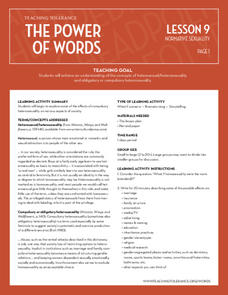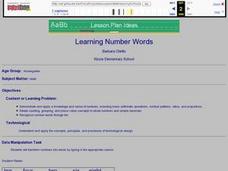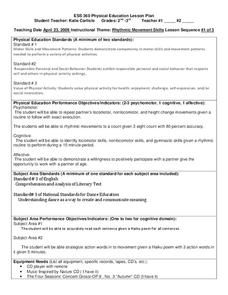Curated OER
The Amazing World of Dictionaries
Use this resource to discuss various ways to dictionaries can be used. What a terrific presentation to display when exploring how dictionaries are used to define words, check spellings, identify parts of speech, and more. The PowerPoint...
Curated OER
Vocabulary Building
Use primary text documents to learn word roots. Learners listen to a reading of the Declaration of Independence and highlight words they don't know. They compile these words and guess their meanings. They discuss roots, prefixes,...
Curated OER
Shall We Practice More Phonemes?
A simple presentation designed for emerging readers. Learners practice saying the sounds that a variety of phonemes produce. As the slides go on, the phonemes are combined to make actual words. Good practice for the young ones!
Curated OER
Syllable Challenge Ball Game
Toss the ball! Help readers listen for the number of syllables in a word. They play an interactive ball game where they toss the ball to a peer and state a word using the number of syllables called out by the teacher. This is a great...
Curated OER
Fruits and Vegetables
Here is a fun way to investigate fruits and vegetables. In this healthy diet and reading lesson plan, learners read and recite several poems about fruits and vegetables. They sort pictures and word cards with assorted names of fruits and...
Curated OER
Slider Word Game
Students investigate the parts of words that can be used to increase reading comprehension with more vocabulary. They create colorful sliders and play a game with them. The game also can be used to for introducing different parts of speech.
Curated OER
Word Walls
Pupils participate in creating a word wall using words important to them and design other organized displays to entice memory and assist in teaching. As a class, they clap out letters of words and solve mystery words from given clues. A...
Curated OER
Telling Time in Words
Writing out time can be tricky! Give your scholars practice with this pair of worksheets featuring both analog and digital clocks. They read the times and write it out in the boxes provided. Make sure you specify that learners are to...
Teaching Tolerance
The Power of Words: Normative Sexuality
High schoolers collect newspaper articles which discuss societies who enforce heterosexuality. They brainstorm how heterosexuality is enforced in their community. They answer questions to end the instructional activity.
Curated OER
My Reading Words in My Social Studies Book?
Connect social studies and language arts using this resource. After studying root words, have learners locate five words from their social studies book that have a prefix, suffix, or root word. This puts a new twist on practicing basic...
Curated OER
THE BLENDING SLIDE
Your beginning readers will practice blending sounds with this hands-on activity! Each learner gets their own paper slide, cards with consonants, and cards with vowels. Then, after practicing as a class, they can blend consonant and...
Curated OER
Do the Word Stretch
Young learners practice putting sounds together to form words. Even though the sound is not functioning on this presentation, the basic premise of leading students through the decoding process is great. There are only four examples,...
Curated OER
Sorting
A lesson on classification and sorting is here for you. Elementary schoolers participate in an interactive computer game in which they sort books by theme. They take a trip to the library to observe and discuss how books are sorted, and...
Curated OER
Learning Number Words
Students practice saying their numbers and identifying the words. They use whole numbers and decimals to practice grouping numbers into different categories. They write the word of the number they are shown.
Curated OER
Clerihew Dances II
Third graders explore rhythm and quality of word and phrased to that of dance. They move to the rhythm of poetry.
Curated OER
Words That Sell
Explore words, definitions, their connotations and associations with brand names. Middle and high schoolers identify words used in commercials and determine their effect upon the consumer population. They explore how meanings are...
Curated OER
Homophones
Use this resource to provide learners with a quick review of common homophones. Learners read words, such as sail and sale, and identify the correct usage. It is a fun way to discuss this topic.
Curated OER
Ow
Discuss the ow sound using this presentation. Learners read a series of words with the ow sound. There are pictures and graphics to make the information accessible. This tool provides a quick and easy way to review this topic.
Curated OER
Sight Words
Practice sight words. There is a list of forty-six words, such as house, very, and half. Learners could use this resource to practice reading or spelling these words. It would also work well as part of a whole group or center activity.
Curated OER
Word Scramble
Have your class play a motivating word game to practice reading skills. Learners take a look at a group of letters and use them to form words. The words all end in the -ay sound. A teacher could use this resource to practice reading,...
Curated OER
Word Endings: -er
Reinforce spelling and reading skills using this presentation focusing on the -er ending. Learners can read the words written on this series of slides, and then come up with their own examples. There are appealing graphics.
Curated OER
Searching For Letters, Words, and Sentences
This simple lesson is designed for K - 1 learners. They are introduced to individual letters, words, and sentences. A game is played where they try to collect one example of each. For practice, students complete a worksheet which is...
Curated OER
Choose the Blend
In this phonics worksheet, students practice pronouncing the pictures on 16 squares. Students discover the consonant blends for each picture. Students cut out each picture and glue them in their appropriate squares on the second page.
Curated OER
Rhythmic Movement Skills
Students explore rhythmic movements. In this performing arts activity, students create their own movements and then repeat the each others movement. Finally, students create movements to the Haiku generated by the entire class.

























